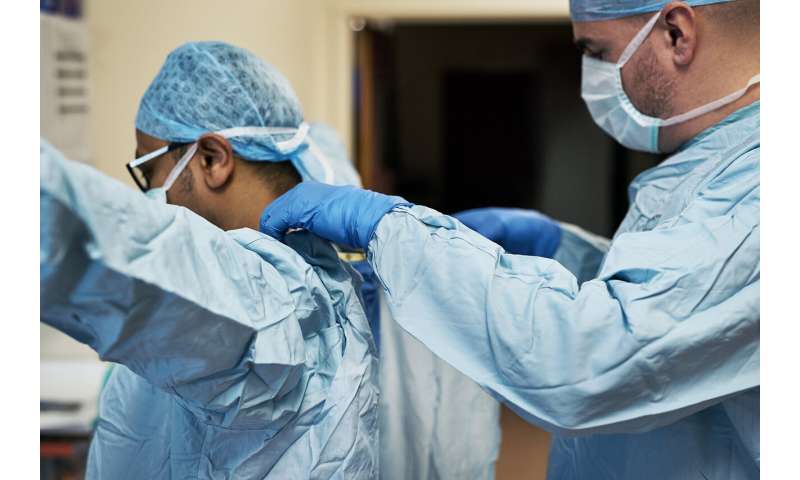
Experts from Philadelphia’s Temple University Hospital have shared their contingency plans for meeting increased demand for hospitalization, as well as their protocols and training plans to minimize health care staff exposure to COVID-19 and ensure proper active and reserve staffing. The report, titled “Mobilization and Preparation o … he COVID-19 Pandemic,” is published online in the Annals of the American Thoracic Society.
“Logistical deficiencies can stress the health care system, but with adequate preparation, we hope to reduce COVID-19 mortality by ensuring that the standard of care is preserved despite the increase in health care utilization,” said first author Junad M. Chowdhury, MD, pulmonary disease and critical care medicine fellow, Division of Thoracic Medicine and Surgery, Temple University Hospital. “In addition, efforts to reduce the possible spread of COVID-19 to patients, visitors and essential health care providers through early detection, isolation and triaging must be emphasized.”
The situation the team faced was especially challenging, as the medical center is located in a medically underserved area and ICU beds are typically at 80 to 90% of capacity during normal operations.
Following is a brief overview (discussed in detail here) of the plan Dr. Chowdhury and colleagues developed to address these challenges. Staff training on safety measures began immediately after the outbreak. An infection control committee drafted PPE protocols, while simulation exercises were conducted on advanced cardiac life support and rapid response. All staff are required to report symptoms online and to have their temperature monitored before and after shifts.
Based on lessons from the COVID outbreak in Wuhan, China, the authors created a screening protocol to stratify patients based on their risk of virus transmission. Inpatients are monitored for COVID-related changes and screened. Patients requiring rapid responses or having cardiac arrest are immediately transferred to the COVID unit if COVID is suspected.
The authors noted, “Initially, all SARS-CoV-2 tests were sent to a third-party diagnostics company, which had a four- to five-day turnaround time. This resulted in an inappropriate use of PPE, delay of discharge of non-COVID patients, and ultimately, an increase in our total census. We developed our own in-house testing, which yielded results in five to 10 hours.” This enabled the team to more effectively triage and discharge patients efficiently.
The team determined that three units were necessary: an isolation unit separate from the main hospital, a unit designated for patients with low probability of COVID infection, and a third unit that functioned as an outpatient COVID screening unit.
Contingency planning included: creating designated backup units, mobilizing ventilators from smaller satellite campuses, asking staff who were not performing essential inpatient services to remain at home on reserve for staffing shortages, creation and enforcement of a strict no-visitor policy, and plans for conservation of PPE and disinfection of solid objects such as phones, glasses and pens.
Dr. Chowdhury and colleagues also developed COVID-specific admission protocols. These covered isolation precautions, specimen collection, imaging and laboratory testing. Once admitted, patients are kept in airborne/droplet isolation and contact isolation until SARS-CoV-2 is ruled out; patients are kept in various states of isolation if they are at varying levels of risk or have a confirmed COVID diagnosis, while COVID-positive patients whose symptoms improve are discharged to home quarantine.
On discharge, close follow-up is done to assure pandemic mitigation. Discharged COVID-19 positive patients are provided with an online portal, where they are required to log in daily to report their symptoms, and are asked to remain in mandatory quarantine for 14 days. Follow-up with these patients is continued for a month, and then again at three and six months. If they are symptomatic, additional tests are ordered.
The hospital’s lung center converted all in-person outpatient appointments to telemedicine visits. All telemedicine patients are asked COVID screening questions when their appointments are made.
As a teaching hospital with a large pulmonary disease and critical care program, program leadership and fellows have worked together to continue lectures, conferences and research meetings via teleconference. Trainees have gained autonomy, experience and knowledge during the pandemic that they would have difficulty obtaining if a pandemic was not in effect.
Source: Read Full Article
